The first issue of Doomsday Clock is here, and with it a chance to explore the world Watchmen left behind – and how it will eventually tie into the wider DC Comics cosmos. While in some ways it’s unsurprising that this world is even grimmer than we left it, there have still been some major changes since we last saw these characters in the original series
Image: DC Comics. Art by Gary Frank and Brad Anderson.

Written by Geoff Johns, and with art from Gary Frank and Brad Anderson, Doomsday Clock #1 opens with the twilight of America. Set just seven years after the conclusion of the landmark original graphic novel – which ended with an unsure new era of peace after Adrian Veidt, AKA Ozymandias, ravaged New York with a giant psychic monster – Doomsday Clock reveals that Veidt’s sacrifice earned less than a decade’s delay on World War III. With Russia invading Europe, and North Korea rattling its nuclear sabre, America stands again on a brink seen in the original Watchmen, but falls off it. News stations fall silent and a new era of American propaganda calmly tells the nation that nuclear war has begun. “The Great Lie” – Veidt’s original plan – has come crashing down all around him.
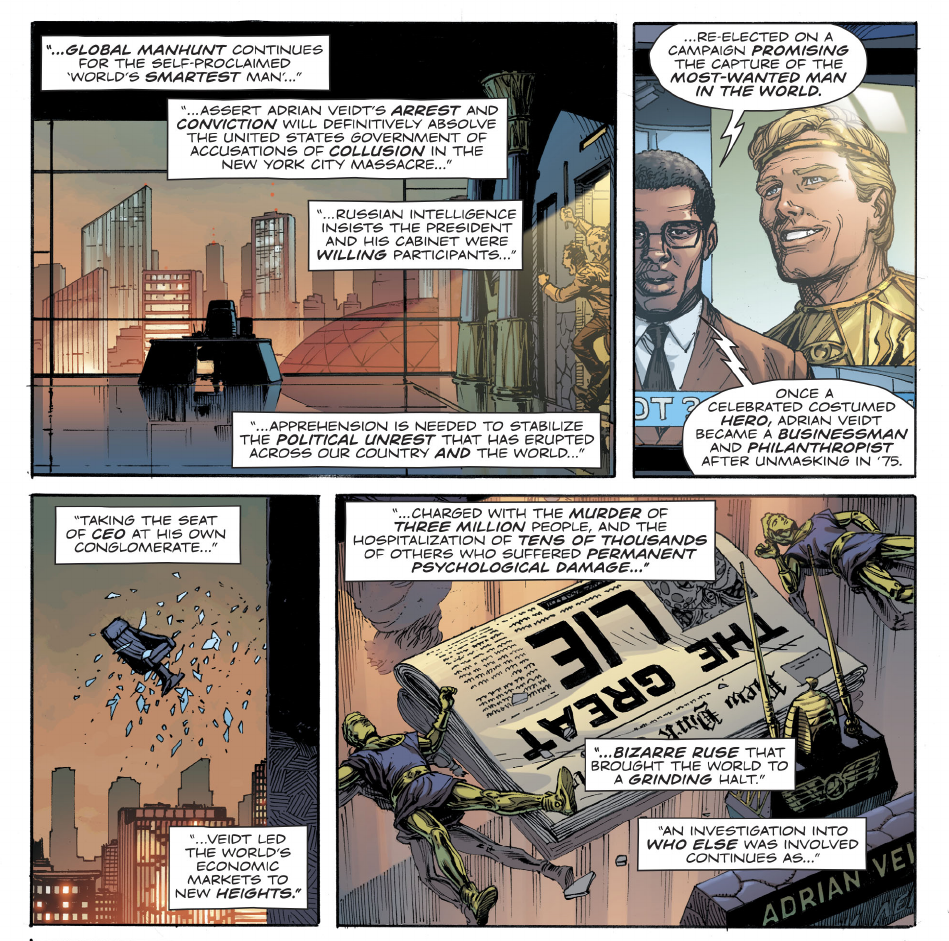
The inevitably of this grim outcome feels right for the world of Watchmen, itself a story of history being doomed to repeat itself, and the sacrifices that must be made to try and break that cycle. “Nothing ever ends,” as Dr Manhattan intoned to Veidt in the closing pages of Watchmen, and Doomsday Clock as a continuation of that never-ending tide of darkness feels familiar, even as it explores uncharted avenues of this world we left behind decades ago.
Intimate parallels and loving embraces of Watchmen‘s iconic style abound in Doomsday Clock, particularly the structure of Frank and Anderson’s artwork. The pair’s designs masterfully honour and then break the nine-panel page style of the original, framing characters across alternate boundaries rather than through the actual separation of frames. What makes Doomsday Clock #1 so fascinating is the subtle ways it diverges from the familiarity of Watchmen to present something new to the audience, even if it’s still within the frame of Watchmen homage. This is shown mostly through the re-introduction of Rorschach, a “shocking” return – already revealed at New York Comic-Con a few months ago – after the character’s literally explosive death in the climax of the original series. But as we quickly learn, this is not the return of the fallen antihero but instead a new character carrying on Rorschach’s legacy.
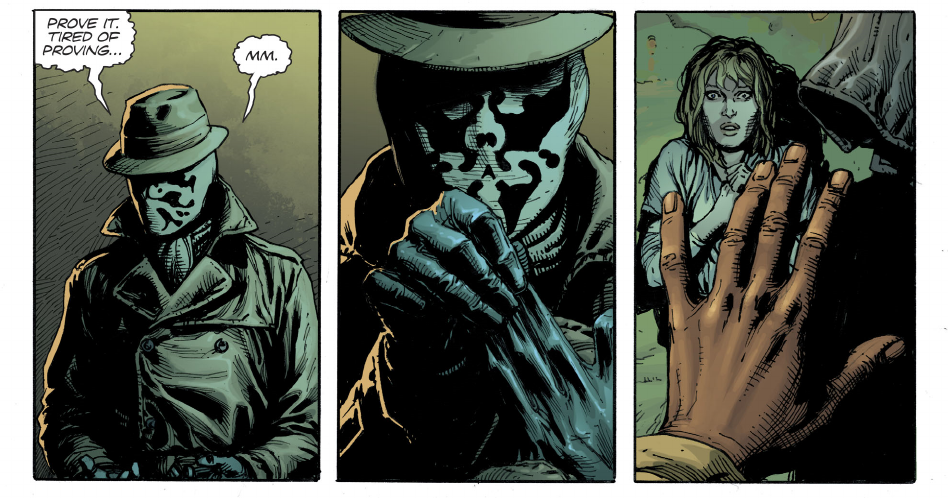
While the world we find in Doomsday Clock feels like a logical, if depressing, continuation of the original Watchmen, the new Rorschach is very different from the original. (The biggest revelation we get is that he’s African-American.) We met the original Rorschach as a skulking, silent figure investigating the Comedian’s apartment. This new character enters the frame more boldly; he’s rough and ready, a threatening figure stalking a prison full of inmates waiting to die in the oncoming apocalypse.
The new Rorschach’s mission is to recover two supervillains, the Marionette and the Mime. The duo are homages to the Charlton Comics characters Punch and Jewlee, just like the Watchmen were extrapolations of other Charlton superheroes. They’re being fetched for a mysterious benefactor, who’s on a quest to “find God”. If working for someone else wasn’t already weird enough, this Rorschach also quickly acquiesces to the demands of the people he’s been hired to extract from prison, an odd characterisation for a hero infamously known for making his last stand on the idea that there could never be compromises.
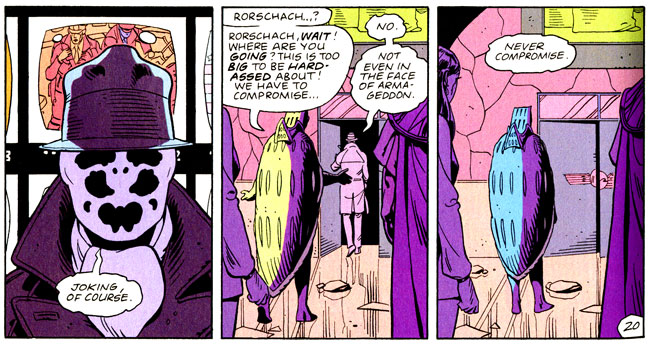
It also becomes apparent how much has changed in the Watchmen world when Rorschach’s benefactor is revealed to be none other than Adrian Veidt himself. The golden conqueror is emerging from years in hiding after his horrific plans for world peace unravelled in the years between the original comic and Doomsday Clock. Instead of the aloof master planner we saw in Watchmen – evading even an omnipotent being such as Dr Manhattan – the Veidt we see here is one willing to work with others he previously saw as below him. He’s also plagued by cancer, keenly aware of his failures, and now knows that the world needs Dr Manhattan now more than it ever needed Adrian Veidt.
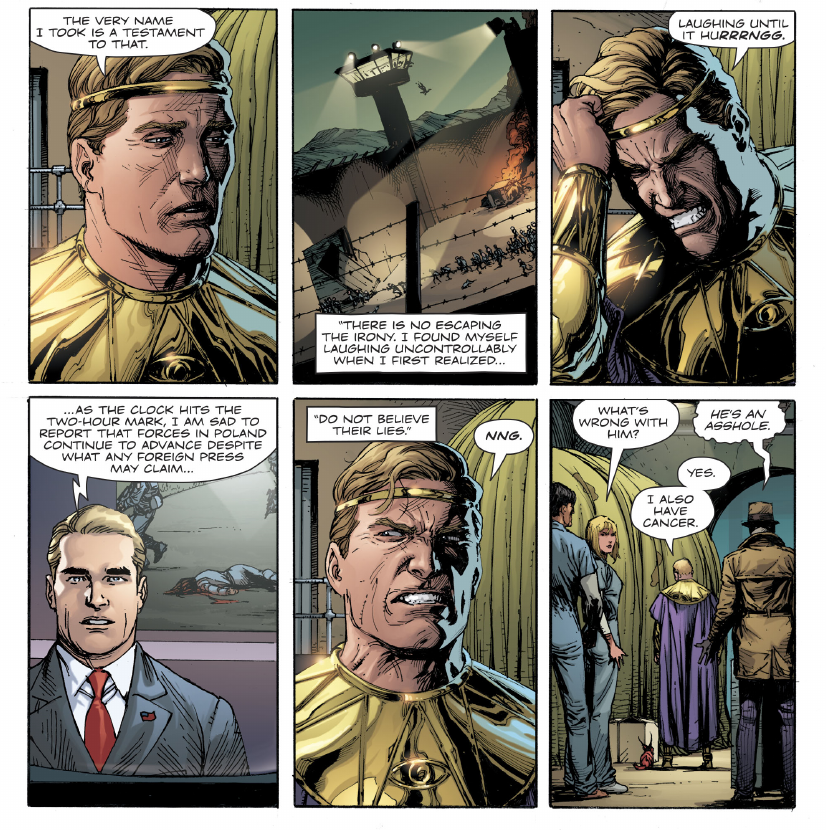
Pushing these characters beyond the familiarity of what we knew of them in Watchmen is a promising start for what Doomsday Clock has planned, and happily, it’s a better choice than simply wallowing in reverence for Alan Moore’s classic graphic novel (which is what the controversial prequel project Before Watchmen did back in 2012). Not all of Johns’ attempts at bringing something new to the Watchmen table are successful; there are clunky allusions to current politics, from a president that golfs while his country crumbles to Rorschach’s talk of “undeplorables” in the opening narration. They don’t land with the bite Johns probably intended them to, and feel like an overwrought comparison stretched a bit too far to quite work. But Doomsday Clock‘s strength in presenting its post-Watchmen world definitely lies in how it plays with the setting Moore, Gibbons and Higgins left behind all those years ago, rather than the moments where it vainly tries to wrap that world around our current one.
Doomsday Clock #1 also begins to lay the groundwork for the conflict that will drive the DC side of things. We know that Dr Manhattan has been been mucking about with the fabric of the DC universe since the earliest days of Rebirth; here, Superman wakes up after a nightmare – itself a rare enough phenomenon that the Man of Steel is unsettled.
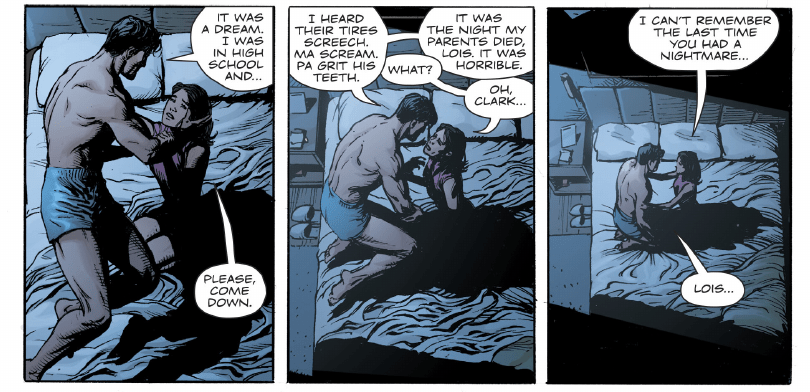
The context of the nightmare is even more unsettling, since it’s of the night his adoptive parents died in a car accident when he was a teenager. We already know, thanks to The Button and recent events in Action Comics, that various manipulations by Dr Manhattan have been using the spectres of lost fatherhood to prevent DC’s greatest heroes, Superman and Batman, from embarking on their Earth-defending careers, to try and destabilise the established order of this universe. The nightmare seems to be a clear sign that Dr Manhattan’s attempts aren’t over.
The first issue of Doomsday Clock is encapsulated in a love for what made the original Watchmen so iconic and respected, but its greatest strengths are found in how it goes beyond it instead of just paying tribute to it. Just how this all plays into the wider DC world remains to be seen, but Doomsday Clock #1 sets up a story that is less of the intriguing conspiracy of the original Watchmen, and more of a climactic reckoning between two very different worlds.
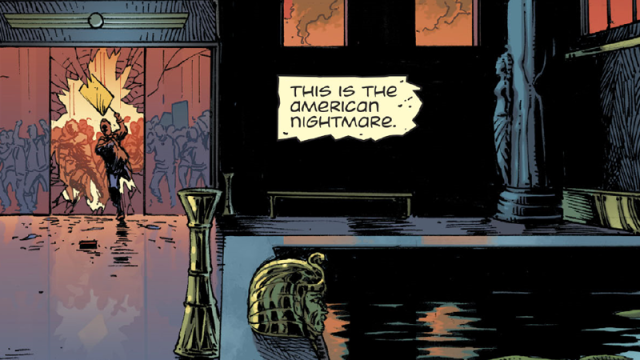
Comments
One response to “DC’s Doomsday Clock Boldly Pushes The Watchmen Into An Even Grimmer, More Nihilistic Future”
It’s probably heretical to say, but as a fan of he original comic, I quite enjoyed this one. Looking forward to see where this goes.